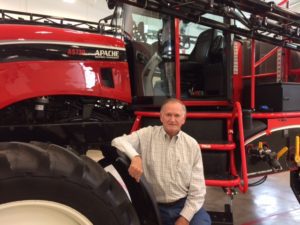We are proud to introduce you to ET Works employee #1, Jim Bates. That’s right, Jim was the first employee of ET at its start in 1996.
Jim came to ET from a large Midwestern farmer cooperative where he was in charge of all sales and witnessed the increasing demand among farmers to purchase and own a self-propelled sprayer. The demand could not be met because there were only a few manufacturers on the market and none of them were focused on selling their products to farmers. Enter Apache – simple, rugged and reliable sprayers for farmers. Jim is our most famous ambassador preaching the virtues of mechanical drive.
Jim’s early work at ET was important to our success. He was able to survey thousands of growers to help understand what they wanted in a sprayer. He served as Vice President of Sales and Marketing for several years and was responsible for finding and bringing on board many of our most successful independent dealers in North America.
In many ways, Jim embodies the spirit of ET and its employees. He is passionate about our product, the company and our people. He gains great satisfaction from helping to drive ET’s success. He is well known throughout the sprayer world, and his passion for the company, professionalism and respect for others have gained him many friends over the years.
Jim also established our export business, including in such countries as Canada, Ukraine, Russia, and Australia and still travels often in his role as Export Manager for ET. We are proud that in 2009, only two years after entry into the market, Apache was the best-selling sprayer in Ukraine. However, Jim maintains the shortest commute to headquarters of any ET employee, living just .6 miles from our headquarters in Mooresville.

Stay Connected
APACHE eNEWSLETTER
Sign Up